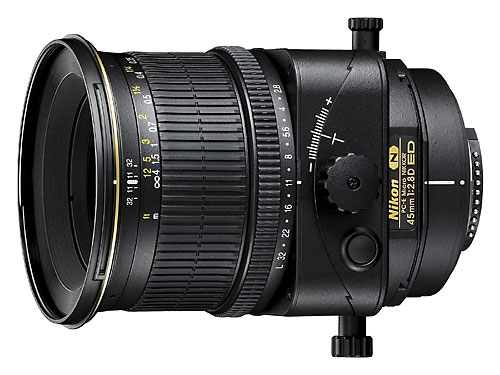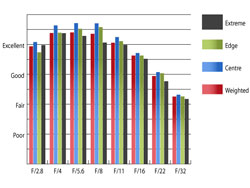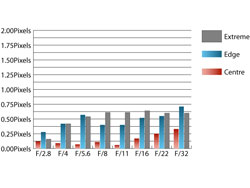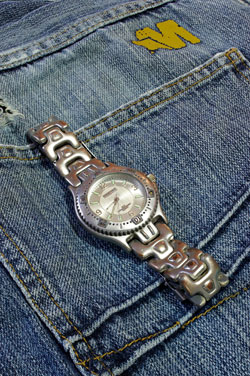Nikon 45mm f/2.8D ED PC-E
 |
| In this review, Gary Wolstenholme takes a look at a highly specialised macro lens with tilt and shift movements, making it ideal for architecture and product photography. |
Nikon's 45mm f/2.8D ED PC-E Micro lens offers the photographer greater creative control through tilt and shift lens movements, whilst also being suitable for close up photography, giving a maximum magnification of half life size. This is a highly specialist lens, so you would need to really want the ability to use the lens movements feature as it costs around £1390. Currently no other third party manufacturer offers an equivalent optic, so if you're looking fo perspective control at this focal length, this is your only option for Nikon at present.
Nikon 45mm f/2.8D ED PC-E Micro: Handling and features
As with other PC-E Nikkors in the range, this 45mm optic can accommodate up to 11.5mm of shift for control of perspective, or 8.5 degrees of tilt to manipulate the focal plane. The lens can also be rotated up to 90degrees clockwise or anticlockwise, with two intermediate stops between. Due to the wide range of lens movements, the lens needs to be capable of covering a much wider image circle, which explains the high price tag, even though the on-paper specification may not seem that exotic without the movements.
Shifting the lens one way or another allows the user to control perspective, for example, correcting converging verticals on buildings. Tilting the lens manipulates the focal plane, allowing the user to either increase or decrease the depth of field for a given aperture. Dials on each side of the lens assembly give precise control of each movement, and two smaller dials allow the tension applied to each control to be adjusted, or to lock the movements in place. All the dials are easily accessible and easy to manipulate.
This is a manual focus lens as the tilt/shift movements would make it very difficult to motorise the focusing process. The aperture is electronically controlled and can be selected via the aperture ring around the lens barrel. To use the lens in Program Auto and Shutter Priority modes, the aperture ring needs to be turned past f/32 to where it says 'L'. As the lens is manual focus, Nikon have kindly provided a hyperfocal scale on the lens barrel. Unfortunately the markings are so close together that it is almost useless, at least it is irrelevant when using tilt movements anyway. The focus control offers just enough resistance to allow for fine focus adjustments easily and focus is confirmed via the camera's autofocus confirmation light.
Overall I found the lens a joy to use. Time needs to be taken to make the most of the movements available, but this is part of the appeal of a lens like this, for me at least.
Nikon 45mm f/2.8D ED PC-E Micro: Performance
From its widest aperture, this optic produces excellent results across the frame. Stopping down a little improves things even more with the lens peaking in quality between f/5.6 and f/8. I have to say I was surprised at how well the lens performs right out towards the edge of the imaging circle, with excellent sharpness being recorded between f/4 and f/11 right across the imaging area. At smaller aperture diffraction starts to take a bite out of the sharpness, but results are still good right down to f/22.
The 45mm PC-E showed a little more chromatic aberration than I'd hoped for, but levels are still wholly acceptable. Levels of CA start off very low across the frame, increasing as the lens is stopped down. They are at their worst at f/32 where they peak at 0.71 pixel widths, which may start to become visible in very high contrast situations.
Due to the wide range of movements with this lens, it is impossible to accurately measure falloff with Imatest across the whole image circle. At f/2.8 the corners of the 35mm imaging area are 1.48stops darker than the image centre, so I would expect more vignetting if using the movements of the lens. Stopping down to f/8 appears to give even illumination across much of the imaging area.
A small amount of barrel distortion is present with Imatest measuring 1.39% barrelling, which I though quite surprising for a prime lens such as this. Luckily the distortion pattern is uniform, so should be easy to correct in image editing software afterwards if necessary.
Nikon's Nano Crystal Coating does a sterling job of suppressing internal reflections which cause ghosting and flare in images. Even in quite strong contra lighting situations, this lens gives a pleasing amount of contrast, with few signs of flare.
Nikon 45mm f/2.8D ED PC-E Micro: Verdict
This lens is a specialist optic constructed without compromise, capable of producing images with outstanding sharpness across the frame. The tilt and shift movements are a joy to use, as the controls feel precise and well laid out. If this kind of lens has tickled your fancy, you will not be disappointed. It may be worth hiring a copy before you buy tough, as it pays to be sure when dropping nearly £1400 on a lens as specialist as this.
 |
| "The Nikon 45mm f/2.8D ED PC-E lens is one of the sharpest lenses I've tested to date." |
 Outstanding optical performance
Outstanding optical performance Very precise controls
Very precise controls Excellent build quality
Excellent build qualityNikon 45mm f/2.8D ED PC-E Micro: Cons
 Almost useless hyperfocal scale
Almost useless hyperfocal scale Maybe a touch pricey, but you get what you pay for.
Maybe a touch pricey, but you get what you pay for.| FEATURES |  |
| HANDLING |  |
| PERFORMANCE |  |
| VALUE |  |
| OVERALL |  |
Nikon 45mm f/2.8D ED PC-E Micro: Lens specification
| Price | £1,390.00 |
| Contact | www.nikon.co.uk |
| Filter size | 77mm |
| Format | Full-frame |
| Construction | 9 elements in 8 groups |
| Angle-of-view | 51° |
| 35mm equivalent focal length (on APS-C body) | 67.5cm |
| Internal focusing | No |
| Image stabilisation | No |
| Minimum focus | 25.3cm |
| Maximum aperture | f/2.8 |
| Minimum aperture | f/32 |
| Weight | 780g |
| Size | 83.5×112mm |
| In the box | Lens Case, Circular hood |
The Nikon 45mm f/2.8D ED PC-E Micro costs around £1390 and is available from Warehouse Express here:
Nikon 45mm f/2.8D ED PC-E Micro
Add your message
Login required
Please login here or if you've not registered, you can register here. Registering is safe, quick and free.
Please login here or if you've not registered, you can register here. Registering is safe, quick and free.
photodo Stats
1102 lenses
428 MTF tests
74 in-depth photodo reviews
100+ users join each day
Help the lens community by reviewing or rating a lens today via our lens search
428 MTF tests
74 in-depth photodo reviews
100+ users join each day
Help the lens community by reviewing or rating a lens today via our lens search
Latest Lens Reviews
- Chinon 28mm f/2.8 Vintage Lens Review
- Canon EF 70-200mm f/4L IS II USM Lens Review
- Samyang AF 85mm f/1.4 EF Review
- Sigma 70mm f/2.8 DG Macro Art Review
- Samyang AF 24mm f/2.8 FE Review
- Meike 50mm f/1.7 Review
- Tamron 70-210mm f/4 Di VC USD Review
- Lensbaby Burnside 35mm f/2.8 Review
- Asahi Super Takumar 50mm f/1.4 Review
- Asahi Super-Multi-Coated Takumar 135mm f/3.5 Review




